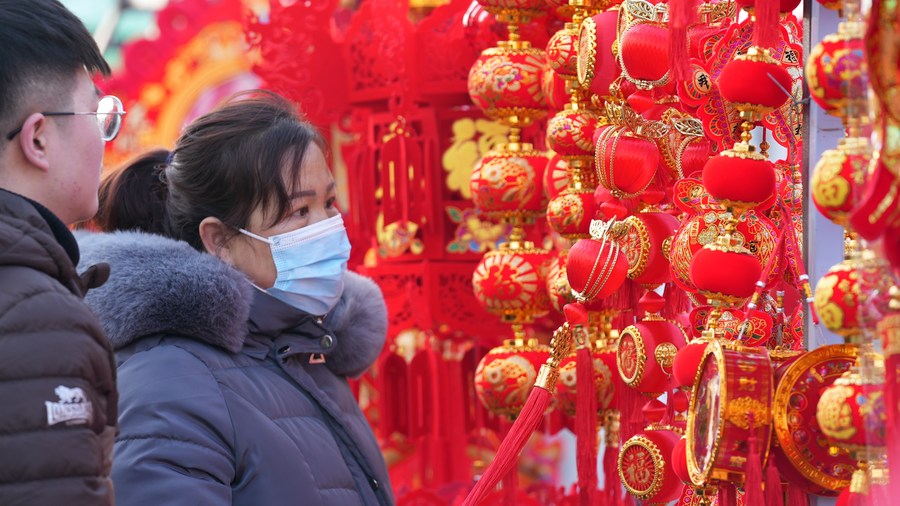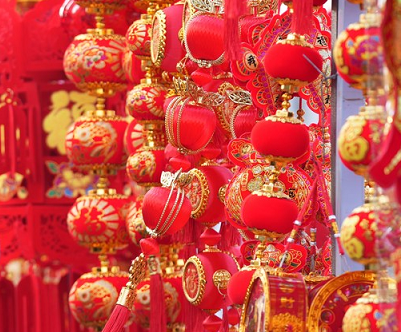
Citizens purchase red lanterns at a festive fair in Yinchuan, northwest China's Ningxia Hui Autonomous Region, Jan. 29, 2022. (Photo by Liu Yufei/Xinhua)
BEIJING, Feb. 4 (Xinhua) -- For many Chinese consumers, the annual shopping spree for the Lunar New Year became a more flavorful experience this year as emerging online channels have helped transform purchasing patterns and expand shopping options.
Getting a taste of the new year through food specialties is not enough. Sales of healthy and high-quality products from across the country and foreign states are flying among consumers due to the convenience of e-commerce and young people's growing appetite for a green lifestyle.
With live streaming in vogue on e-commerce platforms, China's indigenous brands also jumped on the bandwagon and raked in huge profits with products that incorporate Chinese cultural elements.
"CHINA-CHIC"
Traditional culture has come under the spotlight in the country's consumer market, as Guochao, a trend translated as "China-chic," is sweeping across young groups that are obtaining stronger consumption capacity.
Industry data echoed the growth trend. During the online Lunar New Year's Shopping Festival that kicked off on Jan. 10, more than 200 Chinese time-honored brands sold their products through live streaming, according to a report released by Taobao under e-commerce giant Alibaba.
The transaction value of the flagship store of Churin Leaderfoods, selling a typical type of red sausage from northeastern Harbin, skyrocketed during the online shopping festival, while To To Kui, a catering brand known for its Cantonese dim sum, also saw its online sales soar.
Ahead of the Chinese New Year, more companies have launched special items to embrace the China-chic fashion.
"China-chic" has played an important role in the festival gift consumption trend for generation Z, as the order volume of gift box items with Chinese culture elements more than quadrupled, according to JD.com.
"Fancy merchandises for Lunar New Year not only bring delicacies into fashion, but also make traditional culture come alive," said Liu Jianghong, vice head of School of Cultural Industries Management, Communication University of China.
Goods for Lunar New Year are not created out of thin air, but come from the custom and people's interests, Liu added.
NEW CUISINES AT TABLE
Amid uncertainties from COVID-19 that impeded the journeys home in some areas, demands from young people for semi-finished dishes witnessed rapid growth. Sales of semi-finished dishes jumped by over 70 percent on the Ele.me platform.
For young generations that cannot reunite with families and have limited cooking skills, these prepared cuisines are good options that meet their needs for a bumper dinner and retain ceremonial sense.
Delicacies ranging from pepper chicken from southwestern Sichuan to seafood and poultry from southeastern Fujian went viral among post-70s and 80s consumers, the Tmall data showed.
The semi-finished food industry has gained impetus from the rapid pace of modern life. China boasts more than 69,000 catering firms whose names or business scope include quick-frozen stuff, prepared food, semi-finished food, ready-to-eat, and clean vegetables, according to the corporate information provider Tianyancha.
Chinese market volume of this sector topped 300 billion yuan (about 47 billion U.S. dollars) in 2021, while the figure is expected to exceed 830 billion yuan in 2025, said a report by the consulting firm, New Catering Big Data.
SHARING FANCY TASTES
While preparing shopping lists for the Spring Festival, consumers have an eye for purchasing high-quality goods from around China, not only local commodities that used to feature an atmosphere of festivity.
Since the start of the online Lunar New Year's Shopping Festival, postal service for specialties saw a fast increase in both scale and frequency, and consumption enthusiasm for upscale food ingredients was ignited in rural regions.
In the first week of the online shopping spree, orders to non-habitual residence grew by 30 percent year on year, and their proportion soared by over 50 percent from the usual levels, JD.com said.
These orders came mainly from young people, who want to share good tastes with their parents during the special festival, according to the e-commerce platform Meituan. Among inter-provincial orders, more than a quarter were for food and beverages.
On top of domestic specialties, consumers' appetites for imported goods are growing.
About 1,800 live streaming events designed for goods from Shanghai Cooperation Organization member states attracted millions of viewers and raked in nearly 100 million yuan during the online shopping festival.




 A single purchase
A single purchase









